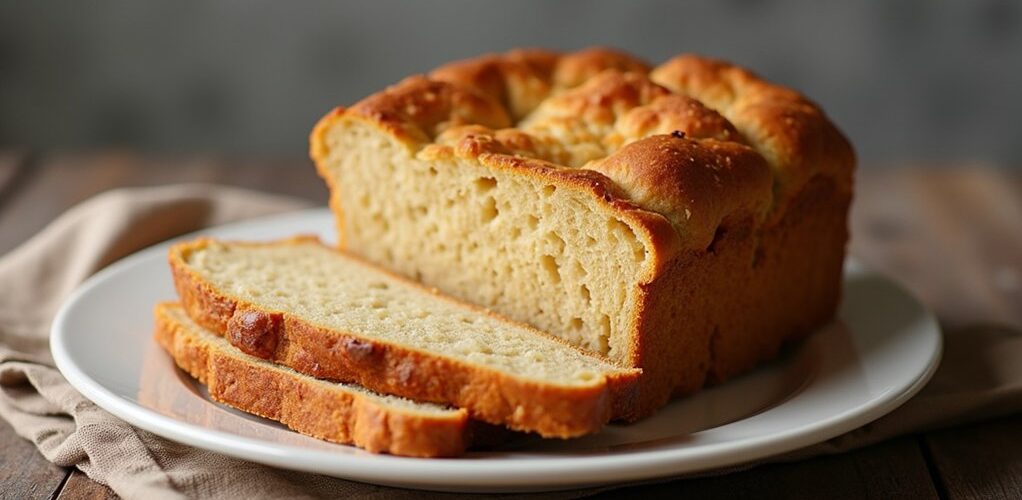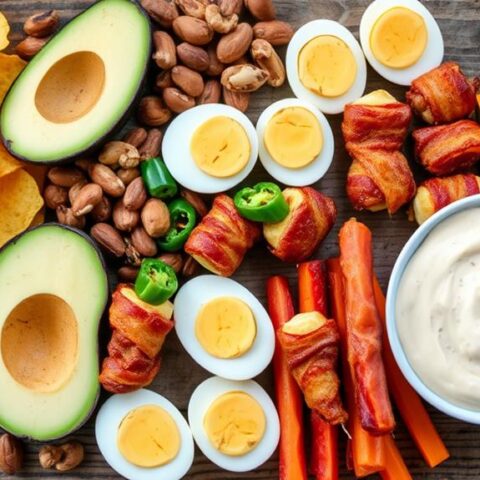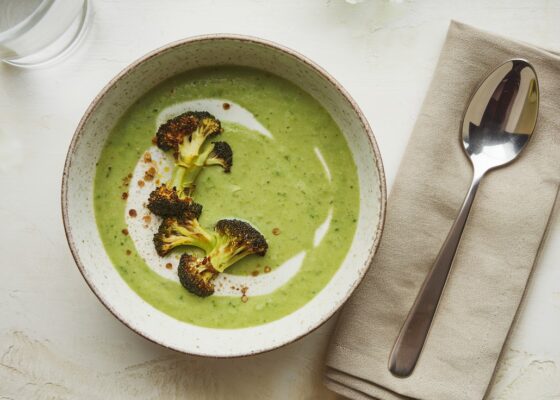
Rye bread is not considered low-carb, containing approximately 48 grams of carbohydrates per 100-gram serving. While it offers valuable nutrients and fiber benefits, with 1.9 grams of fiber per slice, the high carbohydrate content makes it unsuitable for strict low-carb or ketogenic diets. Traditional rye varieties and modern commercial options both maintain significant carbohydrate levels, ranging from 12 to 15.5 grams per slice. Understanding the nutritional composition helps determine how rye bread fits into different dietary approaches.
Key Takeaways
- Rye bread contains approximately 48g of carbohydrates per 100g serving, making it a high-carb food unsuitable for low-carb diets.
- Commercial rye bread slices typically contain 12-15.5g of carbohydrates, similar to regular wheat bread carb content.
- Despite having more fiber than white bread, rye bread's total carb content can trigger blood sugar spikes and affect ketosis.
- Low-carb rye bread alternatives exist, containing 1.8-6g net carbs per slice compared to regular rye's higher carb content.
- Traditional rye bread offers better nutrition than wheat bread but isn't low-carb, with 42.5g net carbs per 100g serving.
Understanding Rye Bread Composition
When examining the composition of rye bread, it becomes clear that this traditional bread variety contains considerable amounts of carbohydrates in its nutritional profile. Rye bread contains approximately 48g of total carbohydrates per 100g serving, with carbs accounting for roughly 77% of its total caloric content, making it unsuitable for most low carb ingredients lists.
While whole grain rye bread offers nutritional benefits through its fiber content, with a typical slice containing 1.9g of fiber, it still delivers about 15.5g of carbohydrates per 32g serving.
Different varieties, such as light and dark rye, vary slightly in their composition, but all maintain relatively high carbohydrate levels. Dark rye, made from whole rye grains, provides more nutrients and fiber but doesn't notably reduce the overall carb content.
Carbohydrate Content in Different Rye Varieties
Traditional rye bread varieties exhibit distinct carbohydrate profiles based on the type of rye flour used in their preparation, with light rye flour containing fewer nutrients but similar carb content to darker varieties.
Modern rye bread production often incorporates wheat flour, which can increase the total carbohydrate content beyond that of traditional pure rye recipes.
The carbohydrate content ranges from approximately 12g per slice in thin-cut varieties to 15.5g in standard whole grain slices, making all rye bread varieties relatively high in carbohydrates regardless of their flour composition.
Rye Flour Type Differences
Although rye bread comes in several varieties, each type contains similar levels of carbohydrates while offering distinct nutritional profiles.
Light rye flour produces bread with approximately 15.5g of carbohydrates per 32g slice, while dark rye bread, made from whole rye grains, maintains comparable carb content despite its richer nutrient density.
The carbohydrate levels remain consistent across different rye flour varieties, averaging 48g per 100g of bread.
Commercial rye breads often incorporate wheat flour blends, which can increase the carbohydrate content beyond traditional levels.
Whether choosing light rye, dark rye, marbled, or pumpernickel varieties, consumers should note that all rye breads contain substantial carbohydrates, making them unsuitable for low-carb dietary requirements.
Traditional Vs Modern Carbs
The evolution of rye bread production has led to notable differences in carbohydrate content between traditional and modern varieties.
While traditional rye bread was crafted exclusively from rye flour, modern varieties often incorporate wheat flour, altering their nutritional profile. This shift has resulted in varying carbohydrate levels across different types of rye bread.
Wholegrain rye bread contains approximately 15.5g of carbohydrates per slice, reflecting its whole grain composition. In contrast, light rye bread, made with refined rye flour, typically features a slightly lower carbohydrate content.
Modern manufacturing methods have introduced diverse flour combinations, resulting in rye breads with carbohydrate contents ranging from 48g to 50g per 100g serving. This variation demonstrates how production methods and flour choices notably impact the final carbohydrate content of rye bread products.
Comparing Rye Bread to Other Bread Types
When comparing rye bread to other common bread varieties, several key nutritional differences emerge.
While rye bread contains similar carbohydrate levels to wheat bread at approximately 48g per 100g serving, it offers distinct advantages regarding dietary fiber content. A single slice of rye bread provides 1.9g of fiber, nearly double the amount found in white bread, making it a more beneficial choice for digestive health.
With respect to overall nutrition, rye bread stands out with its higher concentrations of essential micronutrients, particularly selenium, thiamine, and manganese.
However, despite these health benefits, it's important to note that rye bread's carbohydrate content of 15.5g per slice makes it unsuitable for those following strict low-carb diet protocols or ketogenic eating plans.
Health Benefits of Rye Consumption
Despite its moderate carbohydrate content, rye bread offers numerous health benefits that make it a valuable addition to a balanced diet.
The high dietary fiber content, averaging 1.9g per slice, promotes digestive health and creates a feeling of fullness. Research shows that the soluble fiber in rye bread is particularly effective at lowering cholesterol levels, offering up to 14% greater reduction compared to wheat bread.
Additionally, rye bread's composition supports blood sugar control through its slow digestion and absorption properties. Its rich micronutrient content, including selenium, thiamine, and manganese, provides essential nutrients that surpass those found in white bread.
Regular consumption of rye bread also contributes to improved digestive health by promoting regular bowel movements and reducing constipation risk.
Blood Sugar Impact and Glycemic Load
Understanding how rye bread affects blood sugar levels requires careful consideration of its glycemic properties. With a total carbs content of approximately 48g per 100g serving, rye bread's impact on blood glucose deserves attention, particularly for people following specific dietary protocols.
While the carb count might seem substantial, rye bread's high fiber content of 1.9g per slice helps moderate its effects on blood sugar levels.
The bread's lower glycemic load, compared to white bread alternatives, suggests a more gradual impact on blood glucose. This characteristic makes rye bread potentially more suitable for individuals monitoring their blood sugar response, though individual reactions may vary.
However, those adhering to strict low-carb diets should note that the total carbohydrate content might still exceed their dietary restrictions.
Fiber Content and Net Carb Calculations
To accurately assess rye bread's role in a low-carb diet, calculating its net carbohydrate content proves essential.
While rye bread contains approximately 48g of total carbohydrates per 100g serving, its fiber content provides an important consideration for those monitoring their daily carb intake. A typical slice (32g) delivers about 15g of total carbohydrates and 1.9g of dietary fiber.
To determine the net carbs per slice, subtract the fiber content from total carbohydrates, resulting in approximately 13.1g of net carbs.
Net carbs in rye bread can be calculated by subtracting fiber from total carbohydrates, yielding about 13.1 grams per slice.
Despite having more fiber than white bread, these calculations reveal that rye bread still carries a substantial carbohydrate load. For individuals following a strict low-carb diet, this number may represent a significant portion of their daily allowance, making rye bread a challenging choice for carb-restricted eating plans.
Keto Diet Compatibility Analysis
Since rye bread contains a substantial 48 grams of carbohydrates per 100-gram serving, it poses significant challenges for individuals following a ketogenic diet. With approximately 15 carbs per slice, consuming rye bread can quickly exceed the daily carbohydrate limit of 20-50 grams recommended for maintaining ketosis. The high carbohydrate content of rye bread, with net carbs of 42.5g per 100g, makes it incompatible with keto diet requirements. Those committed to a ketogenic lifestyle should consider low-carb alternatives like almond flour or flaxseed bread, which contain only 1-5g of net carbs per slice. Additionally, monitoring blood glucose levels is essential, as rye bread consumption can trigger blood sugar spikes that disrupt ketosis, compromising the metabolic state necessary for ketogenic success. To maintain ketosis, it is crucial to avoid refined carbohydrates such as rye bread, which can convert swiftly to glucose.
Traditional Vs Modern Rye Bread Making
Traditional rye bread making primarily relied on pure rye flour varieties, ranging from light rye flour made from the endosperm to darker whole-grain varieties that incorporated all parts of the rye kernel.
Modern bread makers often blend rye with wheat flour to achieve different textures and flavors, fundamentally altering the traditional composition and nutritional profile.
The shift from traditional sourdough fermentation to commercial yeast has also changed the bread-making process, affecting both the flavor development and the way the bread's carbohydrates are processed during fermentation.
Traditional Rye Flour Types
While modern rye bread often incorporates wheat flour and various additives, authentic rye bread-making traditions rely on distinct types of rye flour that create unique flavor profiles and textures.
The most basic traditional rye flour types include light rye, which uses white rye flour for a milder taste, and dark rye, produced from whole rye grains for a more robust flavor.
Dark rye flour, with its higher nutrient content, creates denser loaves that offer a more intense taste experience.
Among these traditional varieties, pumpernickel bread stands out, utilizing coarsely ground whole rye grains to achieve its characteristic dark color and subtle sweetness.
Each type of rye flour contributes differently to the bread's final texture, nutritional value, and taste profile.
Modern Flour Blending Methods
Modern rye bread-making practices have evolved greatly from their historical roots, incorporating varied flour blending techniques that distinguish them from traditional methods.
While traditional rye bread relied exclusively on rye flour, modern varieties commonly blend rye with wheat flour to create more palatable textures and flavors for contemporary consumers.
Today's flour blending methods span a spectrum of options, from light rye bread using refined white rye flour to dark rye bread incorporating whole rye grains.
Commercial bakers often mix different ratios of rye and wheat flour to achieve specific characteristics, though this practice considerably alters the nutritional profile of the final product.
The introduction of wheat flour typically increases the overall carbohydrate content compared to traditional rye-only recipes, resulting in breads that deviate from their historical counterparts.
Sourdough Vs Yeast Leavening
Understanding the distinctive characteristics of sourdough and yeast leavening reveals fundamental differences in rye bread production methods that markedly impact both nutrition and flavor profiles.
Traditional sourdough fermentation enhances the nutritional profile of rye bread by increasing mineral bioavailability and reducing antinutrients, while also resulting in a lower glycemic index compared to yeast-leavened varieties.
- The extended fermentation process of sourdough creates a complex, tangy flavor that many enthusiasts prefer.
- Yeast-leavened rye bread offers convenience with its shorter production time.
- Sourdough's natural fermentation improves digestibility and nutrient absorption.
- Modern commercial yeast provides consistent results but sacrifices traditional depth of flavor.
The choice between sourdough and yeast-leavened rye bread ultimately depends on whether priorities lie with traditional nutritional benefits or production efficiency.
Low-Carb Rye Bread Alternatives
For those seeking to reduce their carbohydrate intake without giving up the distinctive taste of rye bread, several promising alternatives exist currently in the market.
Low-carb rye bread options range from commercially prepared varieties containing 1.8 to 6g of net carbs per slice to homemade rye bread alternatives using specialized ingredients.
Almond flour bread typically contains 3-5g of net carbs per slice, while coconut flour varieties offer a slightly sweet profile with 2-4g of net carbs.
Flaxseed bread emerges as one of the lowest-carb options, containing just 1-3g of net carbs per slice while providing a satisfying, hearty texture.
These alternatives often combine ingredients like flax meal, almond flour, and coconut flour to recreate the traditional rye bread experience while maintaining ketogenic-friendly carb levels.
Consider using keto-friendly sweeteners like stevia or erythritol to enhance the flavor of homemade low-carb rye bread without disrupting ketosis.
Making Keto-Friendly Rye-Style Bread
Creating keto-friendly rye-style bread at home opens up new possibilities for low-carb dieters seeking the distinctive flavor and texture of traditional rye.
Using ingredients like almond flour, coconut flour, and flaxseed meal, bakers can craft a bread that maintains a remarkably low carbohydrate profile while delivering essential fiber for digestive health.
These homemade alternatives offer several compelling benefits:
- Contains only 1.8 grams of net carbs per slice
- Delivers 8.4 grams of protein for sustained energy
- Provides 7.5 grams of fiber for improved satiety
- Allows complete control over ingredients and flavors
The incorporation of chia seeds and psyllium husk powder helps achieve an authentic rye-like consistency, making this low-carb alternative particularly appealing for those following a ketogenic lifestyle while craving traditional bread experiences. Many hard cheeses are low in carbs, which complements keto-friendly bread recipes by adding flavor and nutritional value.
Nutritional Profile and Macronutrients
The nutritional composition of traditional rye bread reveals why it cannot be classified as a low-carb food option. With approximately 48g of carbohydrates per 100g serving, rye bread's macronutrient profile consists of 77% carbohydrates, 12% protein, and 11% fat, making it unsuitable for low-carb dietary protocols.
While a single slice (32g) of rye bread contains beneficial nutrients, including 2.7g of protein and 1.9g of fiber, its 15g of carbohydrates per slice remains significant for those monitoring their carb intake.
Though rye bread offers more nutritional benefits than white bread, particularly regarding fiber content and micronutrients, its high carbohydrate content disqualifies it from being considered a low-carb alternative, especially for individuals following ketogenic or carb-restricted eating plans.
Effects on Weight Management
While rye bread offers certain nutritional benefits, its significant carbohydrate content presents challenges for weight management goals. With approximately 15 grams of carbohydrates per slice, rye bread can quickly consume a substantial portion of daily carb allowances, particularly for those following low-carb dietary approaches.
Consider these important factors when evaluating rye bread for weight loss:
- Despite promoting heart health, its high carb content may interfere with weight loss efforts.
- The fiber content aids satiety but cannot offset the total carbohydrate load.
- Blood sugar control benefits may be diminished by the bread's overall carb impact.
- Alternative low-carb options may better support weight management objectives.
For individuals prioritizing weight loss through carbohydrate restriction, exploring lower-carb bread alternatives could prove more beneficial for achieving their desired results. Additionally, improved insulin sensitivity can be achieved through dietary changes, such as adopting a low-carb diet, which may further support weight management by stabilizing blood sugar levels.
Best Practices for Incorporating Rye
When incorporating rye bread into a low-carb lifestyle, careful attention to portion size is essential, as even small servings contribute to daily carbohydrate limits.
Measuring portions and tracking intake helps maintain awareness of carbohydrate consumption, particularly since a single slice contains approximately 15g of carbohydrates.
Pairing rye bread with healthy fats, such as avocado or olive oil-based spreads, can enhance satiety and slow digestion, making each serving more satisfying while potentially reducing overall consumption.
Portion Size Matters
Successfully managing rye bread consumption requires careful attention to portion size, particularly for individuals following a low-carb dietary plan.
Understanding that a typical slice contains approximately 15g of carbohydrates helps in planning daily carbohydrate intake effectively.
Consider these portion control strategies to maintain blood sugar balance:
- Select thinner slices that provide roughly 12g of carbs per serving.
- Measure portions carefully to avoid exceeding daily carbohydrate goals.
- Monitor blood glucose response after consumption to determine personal tolerance.
- Pair with fiber-rich toppings to help moderate blood sugar impact.
Pairing With Healthy Fats
Beyond portion control, the strategic pairing of rye bread with healthy fats transforms this hearty grain into a more balanced nutritional choice for those monitoring their carbohydrate intake.
When combined with healthy fats like avocado, olive oil, or nut butters, rye bread's high fiber content works synergistically to promote better blood sugar levels and enhanced satiety.
Adding omega-3 fatty acids through spreads like flaxseed oil or tahini not only supports heart health but also provides anti-inflammatory benefits.
The combination of rye bread with protein sources, such as eggs or lean meats, further stabilizes blood glucose response.
For additional nutritional benefits, incorporating seeds and nuts as toppings increases both fiber content and healthy fat intake, creating a more complete and satisfying meal option.
Shopping Guide for Lower-Carb Options
Finding low-carb rye bread alternatives at the supermarket requires careful attention to nutritional labels and ingredient lists. When shopping, look for products containing between 1.8 to 6g of net carbs per slice, and check ingredient labels for almond flour, coconut flour, or other low-carb substitutes that maintain rye's distinctive flavor.
To make smart choices when shopping for low-carb rye bread:
- Review the complete nutritional panel, not just the "net carbs" claim.
- Examine ingredient lists for hidden sugars or high-carb additives.
- Compare serving sizes, as some brands reduce carbohydrate content by offering smaller slices.
- Look for products specifically labeled "keto-friendly" that fit within daily carb limits.
Many supermarkets now stock these specialized options in dedicated low-carb sections, making them easier to locate. When selecting healthy fats for a keto diet, it's important to prioritize sources like avocados and olive oil, as they align with the recommended fat intake ratios.
Scientific Research on Rye Metabolism
Scientific studies examining rye metabolism have revealed complex interactions between the grain's carbohydrate structure and human digestive processes. Research indicates that while rye bread contains substantial carbohydrates at 48g per 100g serving, its lower glycemic index compared to wheat bread results in more gradual blood sugar changes.
The high dietary fiber content, particularly soluble fiber, plays a vital role in this metabolic response. Studies have demonstrated that rye bread's fiber composition, approximately 5.8g per 100g, contributes to improved cholesterol levels and cardiovascular health.
However, with net carbohydrates of 42.5g per 100g, the metabolic impact remains significant for those monitoring carb intake. This research underscores why, despite its nutritional benefits, rye bread isn't suitable for low-carb dietary protocols.
Frequently Asked Questions
Is Rye Bread Ok for a Low Carb Diet?
Despite its health benefits and dietary fiber, rye bread's high carb content makes it unsuitable for low-carb diets. Individuals seeking lower glycemic index alternatives should consider bread alternatives with fewer carbohydrates.
What Are the Disadvantages of Rye Bread?
Rye bread's disadvantages include high caloric density, raised glycemic index, potential digestive issues for those with gluten sensitivity, and challenges with portion control due to its nutritional content and filling nature.
What Type of Bread Has the Lowest Carbs?
Flaxseed bread stands as the lowest-carb option among healthy alternatives, containing 1-3g net carbs per slice. Other low carb options include almond flour keto bread and gluten-free coconut flour varieties.
Can You Eat Rye Bread When Trying to Lose Weight?
Rye bread can support weight loss through portion control and calorie counting. Its fiber content offers satiety benefits, though individuals with specific dietary preferences may consider healthier alternatives for ideal weight loss results.
Conclusion
While rye bread contains substantial carbohydrates and isn't considered low-carb, it offers distinct advantages over conventional wheat bread. Its high fiber content, lower glycemic impact, and superior nutrient profile make it a healthier choice for many individuals. Those following a low-carb diet should consume rye bread in moderation, while others can benefit from replacing refined wheat products with whole-grain rye options as part of a balanced diet.










No Comments